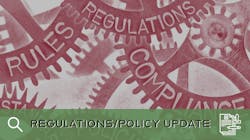As anticipated, the U.S. Department of Energy (DOE) under President Biden's Administration has rolled out rules to enforce a proposed minimum 45-lm/W efficacy threshold for all general service lamps by July 2023 — effectively removing exemptions for specialty and decorative lamps as previously proposed.
Last December, LEDs Magazine reported on commentary from the National Resources Defense Council (NRDC), an environmental activism organization, regarding the pre-publication of the proposed minimum lamp efficacy rule.
The NRDC and consumer advocacy groups including the Consumer Federation of America (CFA) and National Consumer Law Center (NCLC) reacted to the recent announcement, celebrating the next step in energy-efficiency policy that should phase out less-efficient lamp options such as incandescents by way of enforcing a minimum luminous efficacy that many LED GSLs can meet or even exceed today.
To recap, policies outlined in the 2007 Energy Independence and Security Act (EISA) — often informally called "the incandescent bulb ban" — have been on again/off again through the years as the definitions of compliant GSLs have shifted during various administrations. Loopholes resulted that allowed many incandescent and halogen form factors to remain on the U.S. market. In 2017, DOE updated its definitions of GSLs to bring many more GSL form factors beyond the pear-shaped A-lamp under the scope of the efficiency standard.
However, under the Trump Administration, DOE reversed its decision in 2019 and declined to implement a 45-lm/W backstop standard for reflector lamps and candelabra- and globe-shaped lamps, which was planned to go into effect in January 2020.
According to the CFA, although more-efficient LED lamps have been available to consumers, around 30% of lightbulbs purchased in the U.S. during 2020 still represented halogen or incandescent light sources.
Finally, energy-efficiency requirements for GSLs were again revisited under the Biden Administration in 2021, making way for the latest development to adopt updated definitions for GSLs and general service incandescent lamps (GSILs).
In a statement from the NRDC, energy-efficiency advocate Joe Vukovich said, "Implementing these overdue and common-sense light bulb efficiency standards will result in annual utility bill savings of $3 billion for consumers and prevent 222 million tons of dangerous, climate-warming carbon pollution over the next 30 years."
“We applaud forward-looking retailers such as Ikea who have already pulled inefficient light bulbs from their shelves and are selling only energy-efficient LEDs," CFA energy advocate Richard Eckman said. "We urge other retailers to follow their lead and do the same so consumers can benefit starting with their very next purchase."
Visit the DOE website for access to the rulemaking activities updates.
CARRIE MEADOWS is managing editor of LEDs Magazine, with 20 years’ experience in business-to-business publishing across technology markets including solid-state technology manufacturing, fiberoptic communications, machine vision, lasers and photonics, and LEDs and lighting.
For up-to-the-minute LED and SSL updates, follow us on Twitter. You’ll find curated content and commentary, as well as information on industry events, webcasts, and surveys on our LinkedIn page and our Facebook page.





